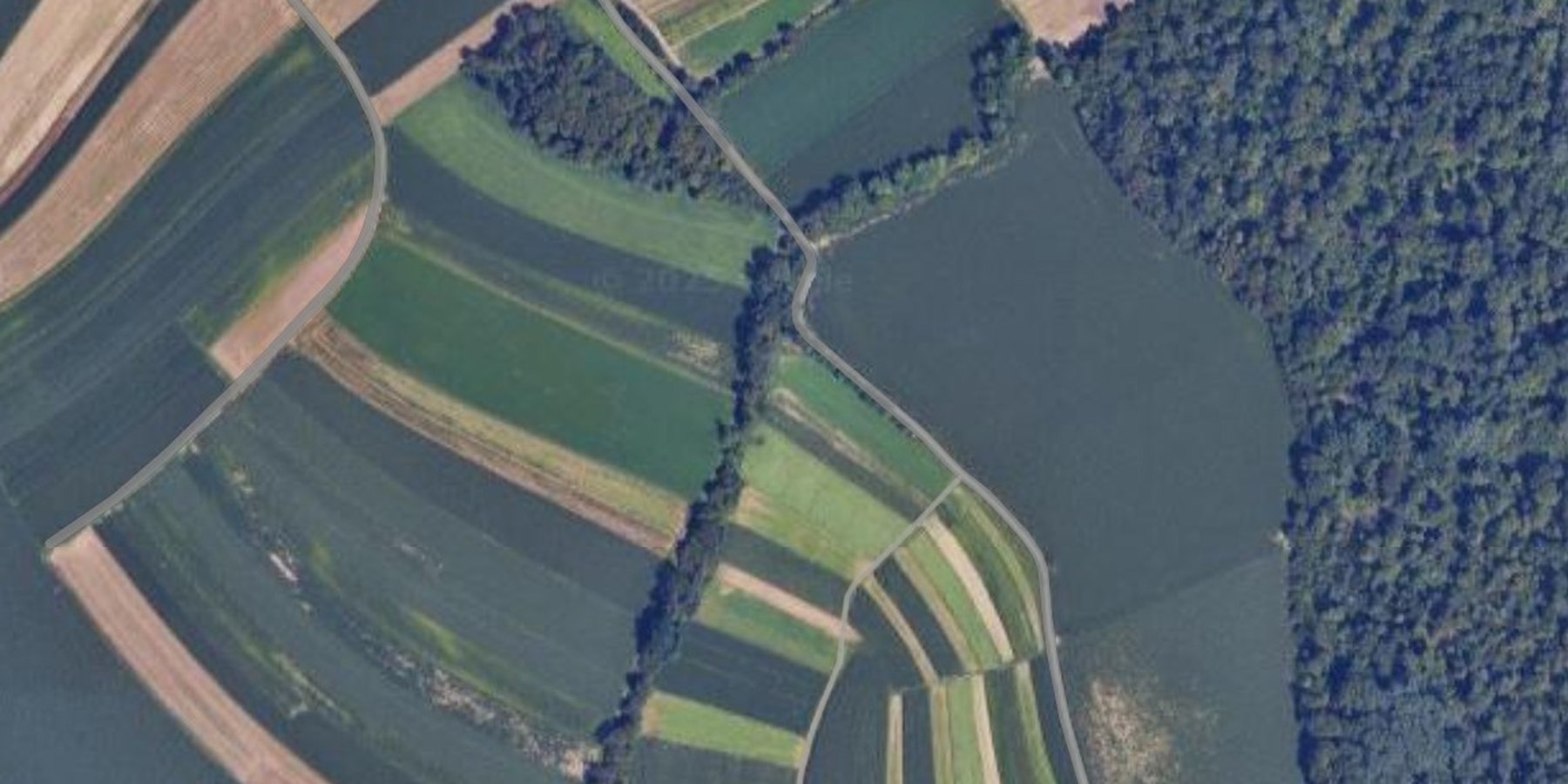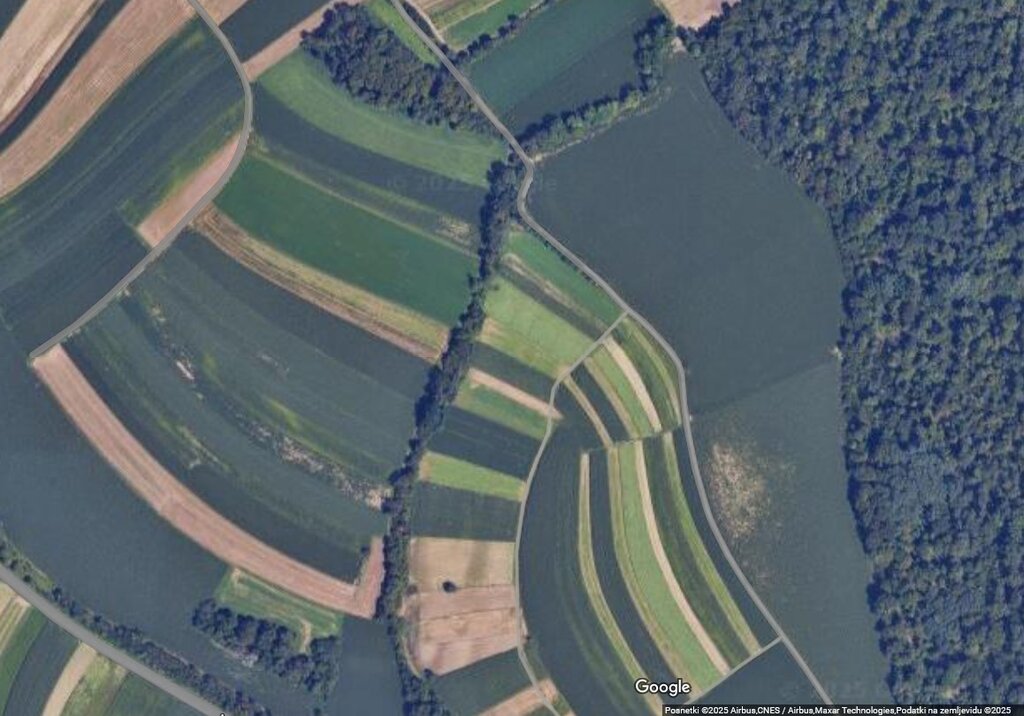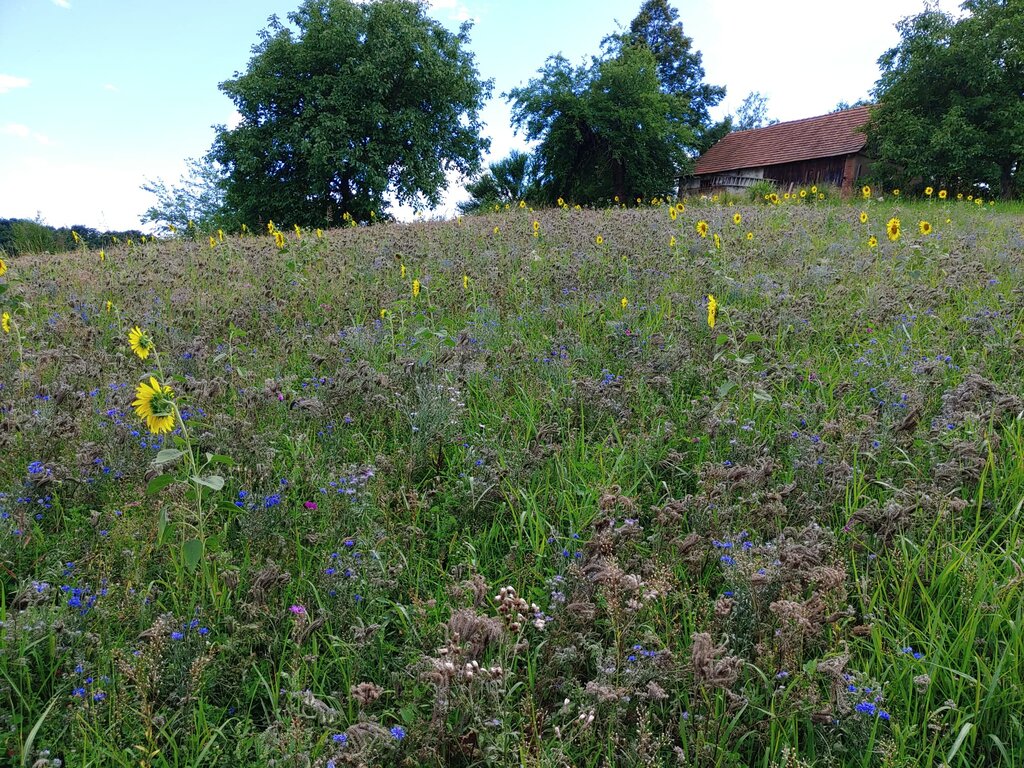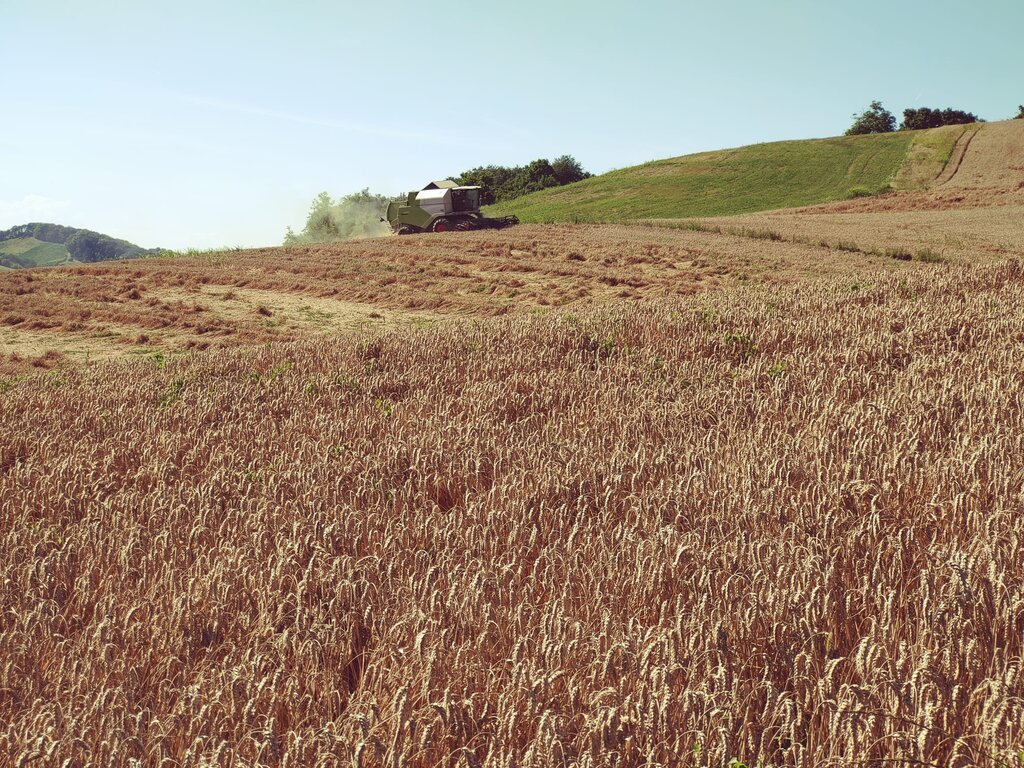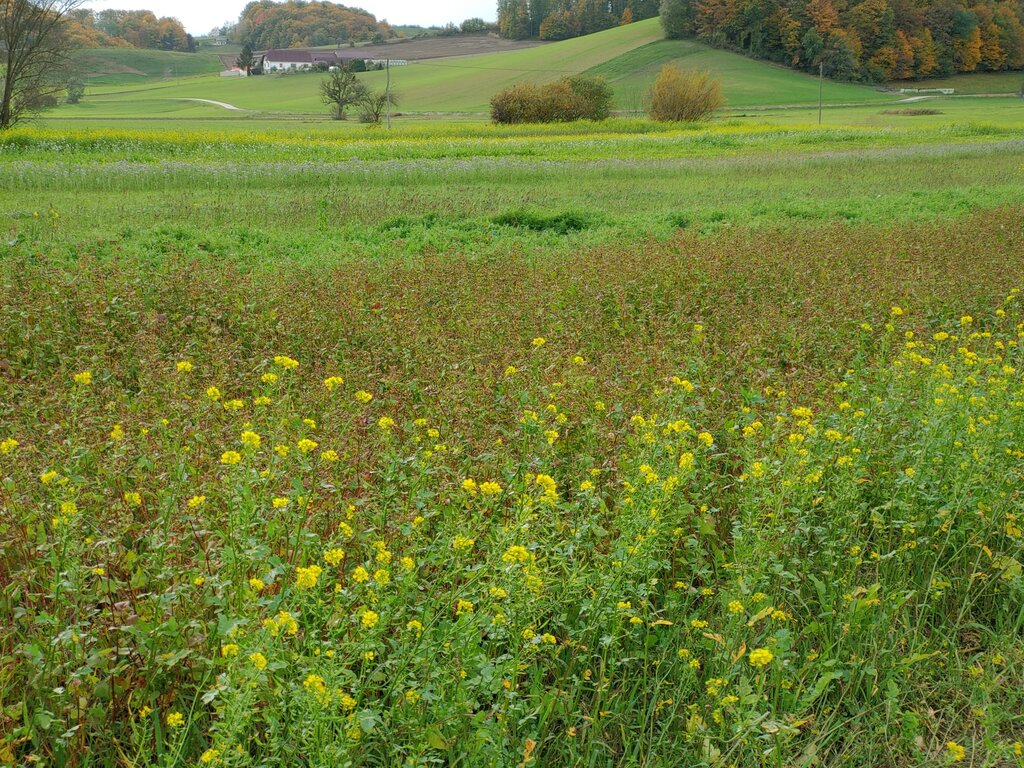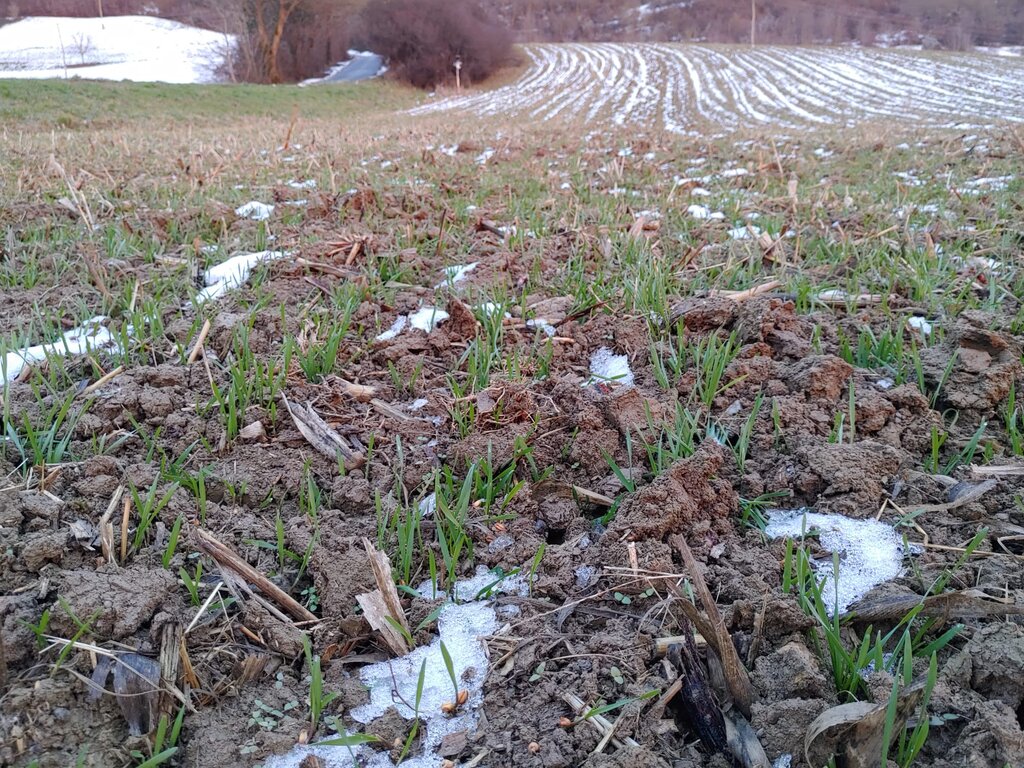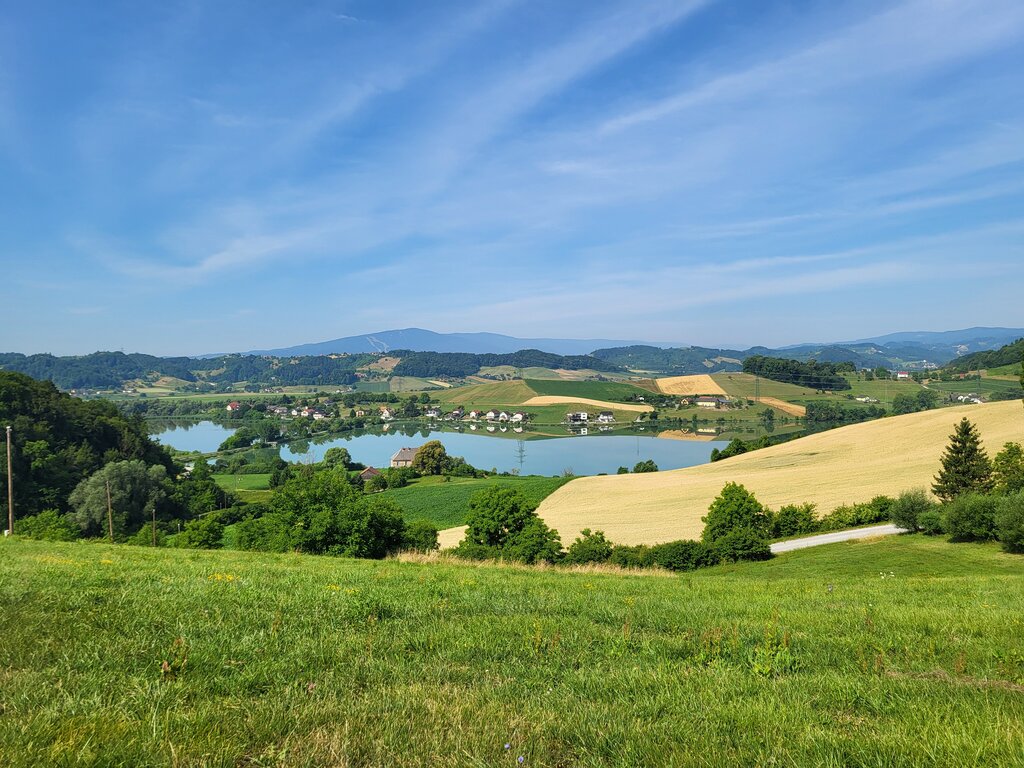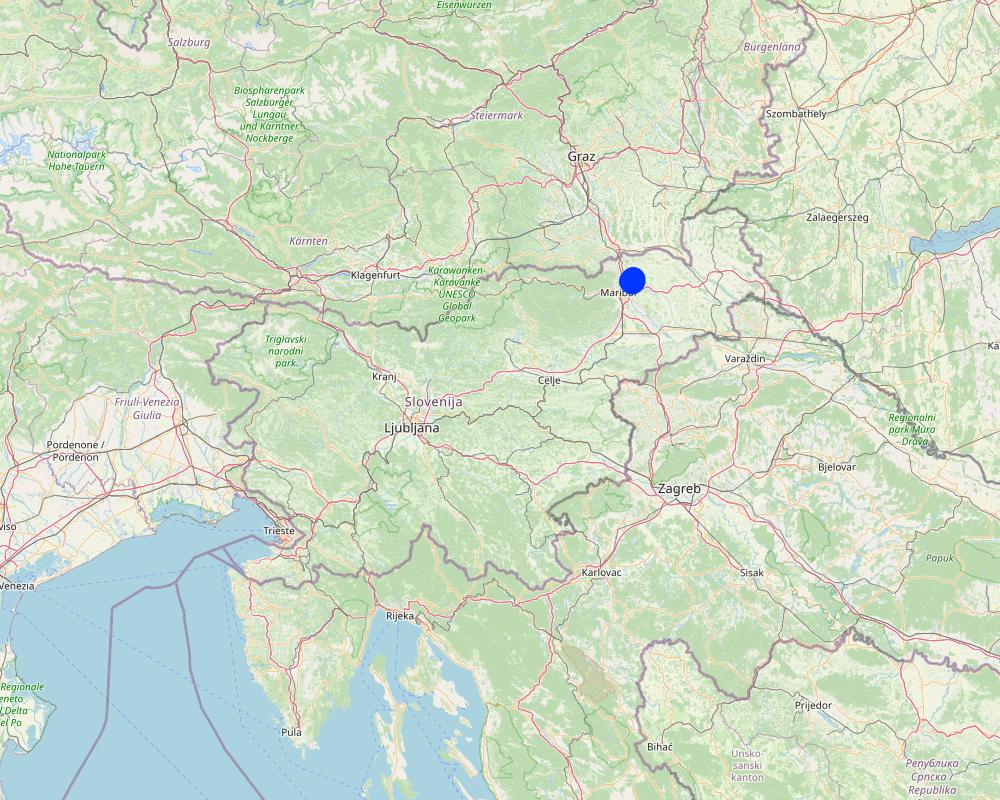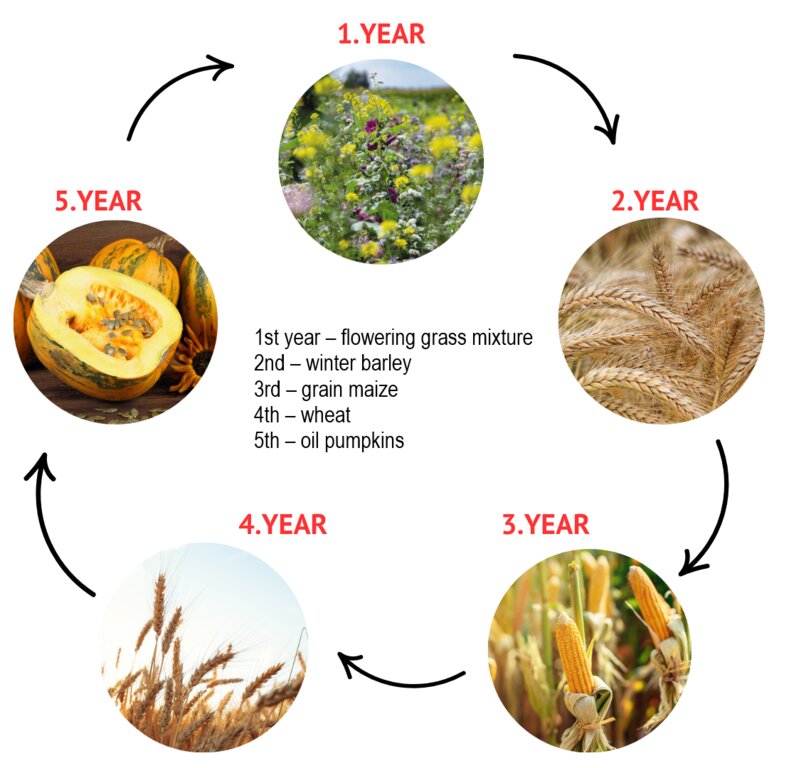5-Year Crop Rotation [Slovénie]
- Création :
- Mise à jour :
- Compilateur : Gregor Kramberger
- Rédacteur : Tamara Korošec
- Examinateurs : Rima Mekdaschi Studer, William Critchley
5-letni kolobar
technologies_6239 - Slovénie
Voir les sections
Développer tout Réduire tout1. Informations générales
1.2 Coordonnées des personnes-ressources et des institutions impliquées dans l'évaluation et la documentation de la Technologie
Spécialiste GDT:
co-compiler:
Horvat Timotej
Chamber of Agriculture and Forestry of Slovenia (KGZS) – Institute of Agriculture and Forestry Maribor
Slovénie
co-compiler:
Viltužnik Martina
Chamber of Agriculture and Forestry of Slovenia (KGZS) – Institute of Agriculture and Forestry Maribor
Slovénie
exploitant des terres:
Ropič Andrej
Farmer
Slovénie
Spécialiste GDT:
Kep Tina
Chamber of Agriculture and Forestry of Slovenia (KGZS) – Institute of Agriculture and Forestry Maribor
Slovénie
Nom du projet qui a facilité la documentation/ l'évaluation de la Technologie (si pertinent)
OPtimal strategies to retAIN and re-use water and nutrients in small agricultural catchments across different soil-climatic regions in Europe (OPTAIN)Nom du ou des institutions qui ont facilité la documentation/ l'évaluation de la Technologie (si pertinent)
Chamber of Agriculture and Forestry of Slovenia – Institute of Agriculture and Forestry Maribor (KGZS) - Slovénie1.3 Conditions relatives à l'utilisation par WOCAT des données documentées
Le compilateur et la(les) personne(s) ressource(s) acceptent les conditions relatives à l'utilisation par WOCAT des données documentées:
Oui
1.4 Déclaration sur la durabilité de la Technologie décrite
Est-ce que la Technologie décrite ici pose problème par rapport à la dégradation des terres, de telle sorte qu'elle ne peut pas être déclarée comme étant une technologie de gestion durable des terres?
Non
2. Description de la Technologie de GDT
2.1 Courte description de la Technologie
Définition de la Technologie:
Crop rotation is good practice in agricultural production. It comprises alternating different types of crops, usually in a specific order. Crop rotation maintains soil fertility, reduces the risk of diseases and pests, and optimizes nutrient utilization. In Slovenia, a 5-year rotation is proving especially effective.
2.2 Description détaillée de la Technologie
Description:
Crop rotation is a system of alternating arable crops, forage plants, aromatic herbs, and vegetables, generally in a specific sequence. It can be applied in fields, gardens, or enclosed growing spaces. Crop rotation is adaptable and can be used under different farming systems, such as organic, integrated, and conventional farming. It maximises the efficiency of biological, organizational, and spatial influences on soil and plants. The fundamental element of crop rotation is the selection of plant species that are most effectively alternated on the same piece of land over different years. To ensure the best selection, it is essential to understand the farming technology, the type and structure of the soil, and its nutrient composition.
By implementing good crop rotation, nutrient utilization is optimized, and the risk of diseases and pests is reduced. Crop rotation also ensures the sustainable use of soil by improving its structure and fertility. The inclusion of cover crops in a rotation helps to maintain continuous soil cover. Crop rotation also facilitates better adaptation to climate change (drought, hail, floods etc), depending on the plants included in the rotation. The inclusion of green manure crops and the use of organic fertilizers can reinforce crop rotation and further support soil fertility enhancement and conservation.
To establish and maintain crop rotation, a detailed plan must be prepared, including the selection of crops based on soil characteristics, nutrient requirements, and crop sequencing needs. A fertilization plan should also be developed in parallel. It is crucial to ensure appropriate agricultural machinery, especially for specialty crops, and to have sufficient labour available, as more complex rotations may increase workload. Additionally, market research for new crops and demand assessment should be conducted.
In summary, crop rotation offers numerous benefits:
- Enhances soil fertility and improves soil structure.
- Reduces diseases, pests, and weeds.
- Minimises nutrient leaching and soil erosion.
- Increases organic matter content in the soil.
- Boosts biodiversity and strengthens soil resilience to weather changes.
- Enables efficient resource utilization and reduces production costs.
Thus, crop rotation offers numerous benefits that farmers appreciate – all of which help ensure higher and more sustainable yields. However, this technology requires specific knowledge, precise planning, and careful scheduling, which increases the complexity of production. It also demands more labour and sometimes additional machinery, leading to higher production costs. Furthermore, marketing various crops requires careful consideration, which can pose a challenge for farmers.
Crop rotation in Slovenia is supported by Agri-Environmental-Climate Payments (CAP), which enables farmers to receive funding for implementing a diverse and effective crop rotation system.
An effective 5-year rotation system in Slovenia typically follows the following sequence:
1st year – flowering grass mixture
2nd – winter barley
3rd – grain maize
4th – wheat
5th – oil pumpkins
This ensures that at least three different annual crops are grown within the five years, while integrating legumes like alfalfa or red clover every 3–4 years to enrich soil nitrogen levels. Cereals may appear up to three times in the rotation, but never in consecutive years. After cereal crops the farmer may alternatively sow non-winter-hardy honey-producing cover crops. Despite this structured guidance, many rotations in Slovenia remain too narrow. National laws and guidelines for agri-environmental measures support farmers in designing good crop sequences.
2.3 Photos de la Technologie
2.5 Pays/ région/ lieux où la Technologie a été appliquée et qui sont couverts par cette évaluation
Pays:
Slovénie
Région/ Etat/ Province:
Jareninski dol, Pernica
Autres spécifications du lieu:
Vosek
Spécifiez la diffusion de la Technologie:
- répartie uniformément sur une zone
Si la Technologie est uniformément répartie sur une zone, précisez la superficie couverte (en km2):
137,0
Est-ce que les sites dans lesquels la Technologie est appliquée sont situés dans des zones protégées en permanence?
Non
Commentaires:
In the case study area of Pesnica, OPTAIN project.
Map
×2.6 Date de mise en œuvre de la Technologie
Si l'année précise est inconnue, indiquez la date approximative: :
- il y a moins de 10 ans (récemment)
2.7 Introduction de la Technologie
Spécifiez comment la Technologie a été introduite: :
- grâce à l'innovation d'exploitants des terres
- au cours d'expérimentations / de recherches
Commentaires (type de projet, etc.) :
Over the years, the farmer has experimented with different farming methods and discovered the benefits of crop rotation. His rotation plan is tailored to the farm’s needs, specific production requirements related to on-farm animal husbandry, and market opportunities. He is one of several farmers in the area practicing crop rotation, which is also supported and encouraged through CAP subsidies.
3. Classification de la Technologie de GDT
3.1 Principal(aux) objectif(s) de la Technologie
- améliorer la production
- réduire, prévenir, restaurer les terres dégradées
- préserver l'écosystème
- conserver/ améliorer la biodiversité
- créer un impact économique positif
3.2 Type(s) actuel(s) d'utilisation des terres, là où la Technologie est appliquée
Les divers types d'utilisation des terres au sein du même unité de terrain: :
Non
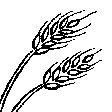
Terres cultivées
- Cultures annuelles
Cultures annuelles - Précisez les cultures:
- céréales - orge
- céréales - maïs
- céréales - blé d'hiver
- cultures florales
- cultures oléagineuses - tournesol, colza, autres
Nombre de période de croissance par an: :
- 1
Est-ce que les cultures intercalaires sont pratiquées?
Non
Est-ce que la rotation des cultures est appliquée?
Oui
Si oui, veuillez préciser:
The technology is based on a 5-year crop rotation, which includes the following crops:
1st year: flowering grass mixture,
2nd year: winter barley,
3rd year: grain maize,
4th year: wheat,
5th year: oil pumpkins.
3.3 Est-ce que l’utilisation des terres a changé en raison de la mise en œuvre de la Technologie ?
Est-ce que l’utilisation des terres a changé en raison de la mise en œuvre de la Technologie ?
- Non (Passez à la question 3.4)
3.4 Approvisionnement en eau
Approvisionnement en eau des terres sur lesquelles est appliquée la Technologie:
- pluvial
3.5 Groupe de GDT auquel appartient la Technologie
- système de rotation (rotation des cultures, jachères, agriculture itinérante)
3.6 Mesures de GDT constituant la Technologie
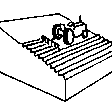
pratiques agronomiques
- A1: Couverture végétale/ du sol
- A2: Matière organique/ fertilité du sol
3.7 Principaux types de dégradation des terres traités par la Technologie
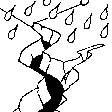
érosion hydrique des sols
- Wt: perte de la couche superficielle des sols (couche arable)/ érosion de surface
- Wg: ravinement/ érosion en ravines
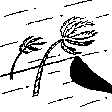
érosion éolienne des sols
- Et: perte de la couche superficielle des sols (couche arable)
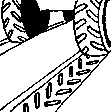
dégradation physique des sols
- Pc: compaction
- Pk: scellage et encroûtement
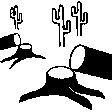
dégradation biologique
- Bc: réduction de la couverture végétale
- Bh: perte d’habitats
- Bq: baisse de la quantité/ biomasse
- Bs: baisse de la qualité et de la composition/ diversité des espèces
- Bp: augmentation des insectes nuisibles (ravageurs)/ maladies, baisse des prédateurs

dégradation hydrique
- Hp: baisse de la qualité des eaux de surface
- Hq: baisse de la qualité des eaux souterraines
3.8 Prévention, réduction de la dégradation ou réhabilitation des terres dégradées
Spécifiez l'objectif de la Technologie au regard de la dégradation des terres:
- prévenir la dégradation des terres
- réduire la dégradation des terres
4. Spécifications techniques, activités, intrants et coûts de mise en œuvre
4.1 Dessin technique de la Technologie
Spécifications techniques (associées au dessin technique):
Crop sequencing: At least three different types of annual crops must be included within a five-year period.
Time intervals: Leguminous plants such as alfalfa or red clover must be incorporated every 3–4 years. In the case of maize, it can be included in the rotation a maximum of three times within five years, but never consecutively. Similarly, cereals can be included a maximum of three times in the five-year rotation.
Cover Crops: Mandatory in areas prone to erosion and where maize constitutes more than 50% of the rotation. Do not count as one of the three different agricultural crops that must be included in the five-year rotation.
Auteur:
Martina Viltužnik
Date:
21/02/2025
4.2 Informations générales sur le calcul des intrants et des coûts
Spécifiez la manière dont les coûts et les intrants ont été calculés:
- par superficie de la Technologie
Indiquez la taille et l'unité de surface:
28.6 hectares
Si vous utilisez une unité de superficie locale, indiquez le facteur de conversion vers un hectare (p.ex. 1 ha = 2.47 acres): 1 ha = :
1 ha = 10.000 m2
autre/ monnaie nationale (précisez):
EUR
Indiquez le taux de change des USD en devise locale, le cas échéant (p.ex. 1 USD = 79.9 réal brésilien): 1 USD = :
0,85
Indiquez le coût salarial moyen de la main d'œuvre par jour:
114
4.3 Activités de mise en place/ d'établissement
| Activité | Calendrier des activités (saisonnier) | |
|---|---|---|
| 1. | Purchase of a roller | 1st year |
Commentaires:
At the beginning, the farm is assumed to be equipped with standard agricultural machinery. However, to expand the crop rotation to a 5-year system, additional specialized equipment is usually required for cultivating new crops. Such machinery is later typically used for around 20 years or more, although the standard depreciation period for such equipment is approximately 12 years. This is only an estimated time frame, as actual usage may vary. Farmers generally continue using the roller as long as it remains functional and economically viable. Depreciation was not included in the cost calculation, as it is generally accounted for at the whole-farm level rather than per individual measure/crop production.
4.4 Coûts et intrants nécessaires à la mise en place
| Spécifiez les intrants | Unité | Quantité | Coûts par unité | Coût total par intrant | % des coût supporté par les exploitants des terres | |
|---|---|---|---|---|---|---|
| Equipements | Roller | piece | 1,0 | 6100,0 | 6100,0 | 70,0 |
| Coût total de mise en place de la Technologie | 6100,0 | |||||
| Coût total de mise en place de la Technologie en dollars américains (USD) | 7176,47 | |||||
Si le coût n'est pas pris en charge à 100% par l'exploitant des terres, indiquez qui a financé le coût restant:
Part of the agricultural machinery intended for the implementation of environmental measures can be funded through non-repayable grants from European and national funds under the CAP.
4.5 Activités d'entretien/ récurrentes
| Activité | Calendrier/ fréquence | |
|---|---|---|
| 1. | Total variable costs of grain maize production | Once a year |
| 2. | Total variable costs of barley production | Once a year |
| 3. | Total variable costs of wheat production | Once a year |
| 4. | Total variable costs of oil pumpkin production | Once a year |
| 5. | Total variable costs of flowering grass mixture production | Once a year |
Commentaires:
Variable costs represent the total production costs for each specific crop, including seeds, plant nutrients, plant protection products, other material costs, variable machinery and labor costs, insurance, and financing costs.
4.6 Coûts et intrants nécessaires aux activités d'entretien/ récurrentes (par an)
| Spécifiez les intrants | Unité | Quantité | Coûts par unité | Coût total par intrant | % des coût supporté par les exploitants des terres | |
|---|---|---|---|---|---|---|
| Autre | Variable costs of grain maize production | ha | 5,72 | 1518,0 | 8682,96 | 100,0 |
| Autre | Variable costs of barley production | ha | 5,72 | 1112,0 | 6360,64 | 100,0 |
| Autre | Variable costs of wheat production | ha | 5,72 | 1354,0 | 7744,88 | 100,0 |
| Autre | Variable costs of oil pumpkin production | ha | 5,72 | 2061,0 | 11788,92 | 100,0 |
| Autre | Variable costs of flowering grass mixture production | ha | 5,72 | 477,3 | 2730,16 | 100,0 |
| Coût total d'entretien de la Technologie | 37307,56 | |||||
| Coût total d'entretien de la Technologie en dollars américains (USD) | 43891,25 | |||||
Commentaires:
The farmer cultivates a total of 28.6 hectares of arable land, theoretically divided into five equal parts under the 5-year crop rotation system. For comparison purposes only, if a simpler system with just maize, wheat, and barley were used and the 28.6 ha were equally divided into three parts (9.53 ha per crop), the total variable costs would amount to 37,967.52 €. Such an even distribution is not practiced in reality—it is used here solely to illustrate the cost comparison.
4.7 Facteurs les plus importants affectant les coûts
Décrivez les facteurs les plus importants affectant les coûts :
The total area is theoretically divided into five equal parts, following the 5-year crop rotation system. However, in practice, this division is not perfectly even. Other important cost factors include variations in input prices (such as seeds, fertilizers, and plant protection products), machinery costs, labor availability, and weather conditions that impact yields and operational efficiency.
5. Environnement naturel et humain
5.1 Climat
Précipitations annuelles
- < 250 mm
- 251-500 mm
- 501-750 mm
- 751-1000 mm
- 1001-1500 mm
- 1501-2000 mm
- 2001-3000 mm
- 3001-4000 mm
- > 4000 mm
Spécifiez la pluviométrie moyenne annuelle (si connue), en mm:
1032,00
Spécifications/ commentaires sur les précipitations:
Most precipitation falls in summer, the months with the highest average precipitation are August and September, the least precipitation falls in winter, in January and February at least, and in principle more precipitation falls in autumn than in spring.
Indiquez le nom de la station météorologique de référence considérée:
Jareninski Vrh (1991-2020)
Zone agro-climatique
- subhumide
The average annual air temperature at Jareninski Vrh during the reference period 1991–2020 was 10.1 °C.
5.2 Topographie
Pentes moyennes:
- plat (0-2 %)
- faible (3-5%)
- modéré (6-10%)
- onduleux (11-15%)
- vallonné (16-30%)
- raide (31-60%)
- très raide (>60%)
Reliefs:
- plateaux/ plaines
- crêtes
- flancs/ pentes de montagne
- flancs/ pentes de colline
- piémonts/ glacis (bas de pente)
- fonds de vallée/bas-fonds
Zones altitudinales:
- 0-100 m
- 101-500 m
- 501-1000 m
- 1001-1500 m
- 1501-2000 m
- 2001-2500 m
- 2501-3000 m
- 3001-4000 m
- > 4000 m
Indiquez si la Technologie est spécifiquement appliquée dans des:
- non pertinent
5.3 Sols
Profondeur moyenne du sol:
- très superficiel (0-20 cm)
- superficiel (21-50 cm)
- modérément profond (51-80 cm)
- profond (81-120 cm)
- très profond (>120 cm)
Texture du sol (de la couche arable):
- moyen (limoneux)
Texture du sol (> 20 cm sous la surface):
- moyen (limoneux)
Matière organique de la couche arable:
- moyen (1-3%)
5.4 Disponibilité et qualité de l'eau
Profondeur estimée de l’eau dans le sol:
5-50 m
Disponibilité de l’eau de surface:
bonne
Qualité de l’eau (non traitée):
uniquement pour usage agricole (irrigation)
La qualité de l'eau fait référence à:
eaux de surface
La salinité de l'eau est-elle un problème? :
Non
La zone est-elle inondée?
Oui
Régularité:
épisodiquement
Commentaires et précisions supplémentaires sur la qualité et la quantité d'eau:
Hydromelioration was carried out in the area, a drainage system and water retention systems (e.g. ponds and basins) were arranged.
5.5 Biodiversité
Diversité des espèces:
- moyenne
Diversité des habitats:
- moyenne
5.6 Caractéristiques des exploitants des terres appliquant la Technologie
Sédentaire ou nomade:
- Sédentaire
Orientation du système de production:
- commercial/ de marché
Revenus hors exploitation:
- 10-50% de tous les revenus
Niveau relatif de richesse:
- moyen
Individus ou groupes:
- individu/ ménage
Niveau de mécanisation:
- mécanisé/ motorisé
Genre:
- hommes
Age des exploitants des terres:
- personnes d'âge moyen
5.7 Superficie moyenne des terres utilisées par les exploitants des terres appliquant la Technologie
- < 0,5 ha
- 0,5-1 ha
- 1-2 ha
- 2-5 ha
- 5-15 ha
- 15-50 ha
- 50-100 ha
- 100-500 ha
- 500-1 000 ha
- 1 000-10 000 ha
- > 10 000 ha
Cette superficie est-elle considérée comme de petite, moyenne ou grande dimension (en se référant au contexte local)?
- moyenne dimension
5.8 Propriété foncière, droits d’utilisation des terres et de l'eau
Propriété foncière:
- individu, avec titre de propriété
Droits d’utilisation des terres:
- loué
- individuel
Droits d’utilisation de l’eau:
- communautaire (organisé)
Est-ce que les droits d'utilisation des terres sont fondés sur un système juridique traditionnel?
Non
Précisez:
Based on national legal system.
5.9 Accès aux services et aux infrastructures
santé:
- pauvre
- modéré
- bonne
éducation:
- pauvre
- modéré
- bonne
assistance technique:
- pauvre
- modéré
- bonne
emploi (par ex. hors exploitation):
- pauvre
- modéré
- bonne
marchés:
- pauvre
- modéré
- bonne
énergie:
- pauvre
- modéré
- bonne
routes et transports:
- pauvre
- modéré
- bonne
eau potable et assainissement:
- pauvre
- modéré
- bonne
services financiers:
- pauvre
- modéré
- bonne
6. Impacts et conclusions
6.1 Impacts sur site que la Technologie a montrés
Impacts socio-économiques
Production
production agricole
Commentaires/ spécifiez:
A diverse crop rotation helps maintain stable yields over a longer period by improving soil fertility, reducing disease pressure, and optimizing nutrient availability.
qualité des cultures
Commentaires/ spécifiez:
Reduced disease and pest pressure lead to healthier, more resilient plants, while increased natural soil fertility enhances overall crop quality.
production fourragère
Commentaires/ spécifiez:
The crop rotation provides an additional opportunity to grow forage crops for feed.
risque d'échec de la production
Commentaires/ spécifiez:
A diverse crop rotation enhances system resilience, reducing the risk of production failure in cases of natural disasters such as droughts or heavy rainfall and decreases the possibility of pest invasion and disease.
diversité des produits
Commentaires/ spécifiez:
Additional crops in the rotation contribute to production diversification, reducing dependence on a single crop.
gestion des terres
Commentaires/ spécifiez:
Crop rotation requires more complex land management, planning, and agronomic expertise.
Disponibilité et qualité de l'eau
qualité de l'eau potable
Commentaires/ spécifiez:
Reduced use of plant protection products and synthetic fertilizers helps protect drinking water quality.
Revenus et coûts
dépenses pour les intrants agricoles
Commentaires/ spécifiez:
Lower use of plant protection products and synthetic fertilizers reduces input costs. Some crops in the rotation have somewhat higher seed and labour costs.
diversité des sources de revenus
Commentaires/ spécifiez:
The diversity of crops leads to a more diversified income from multiple sources.
charge de travail
Commentaires/ spécifiez:
A diverse crop rotation increases workload due to more complex crop management, additional agronomic tasks, and greater administrative demands, requiring efficient planning and organization.
Impacts socioculturels
sécurité alimentaire/ autosuffisance
Commentaires/ spécifiez:
Some crops that currently dominate monocultures can be replaced with alternative plants, contributing to increased overall self-sufficiency.
Impacts écologiques
Cycle de l'eau/ ruissellement
qualité de l'eau
Commentaires/ spécifiez:
Reduced use of plant protection products and synthetic fertilizers helps improve overall water quality. Various root systems help to better use the nitrogen and other nutrients.
Sols
cycle/ recharge des éléments nutritifs
Commentaires/ spécifiez:
Including nitrogen-fixing legumes in the crop rotation enhances nutrient cycling and soil recharge. Different crops have different nutrient requirements and different root systems extract nutrients from different depths.
matière organique du sol/ au dessous du sol C
Commentaires/ spécifiez:
Including crops with higher organic residues contributes to increased soil organic matter and carbon storage.
Biodiversité: végétale, animale
Couverture végétale
Commentaires/ spécifiez:
Flowering plants included in the rotation provide a beneficial habitat for pollinators and other insects.
biomasse/ au dessus du sol C
Commentaires/ spécifiez:
Increased organic residues contribute to higher above-ground biomass and carbon storage.
diversité végétale
Commentaires/ spécifiez:
Increased diversity of plant species in the crop rotation.
espèces étrangères envahissantes
Commentaires/ spécifiez:
Crop rotation helps prevent the establishment of invasive species by creating less favorable conditions for their spread.
espèces bénéfiques
Commentaires/ spécifiez:
The inclusion of more flowering plants supports a higher population of beneficial insects.
contrôle des animaux nuisibles/ maladies
Commentaires/ spécifiez:
A diverse crop rotation helps prevent the spread of diseases and pests.
Précisez l'évaluation des impacts sur site (sous forme de mesures):
The data have not been obtained through specific measurements but rather through a questionnaire with the farmer and insights from other farms and agricultural advisors.
6.2 Impacts hors site que la Technologie a montrés
pollution des rivières/ nappes phréatiques
Commentaires/ spécifiez:
Reduced use of plant protection products and fertilizers helps minimize groundwater and river pollution.
Précisez l'évaluation des impacts extérieurs (sous forme de mesures):
The data have not been obtained through specific measurements but rather through a questionnaire with the farmer and insights from other farms and agricultural advisors.
6.3 Exposition et sensibilité de la Technologie aux changements progressifs et aux évènements extrêmes/catastrophes liés au climat (telles que perçues par les exploitants des terres)
Changements climatiques progressifs
Changements climatiques progressifs
| Saison | Augmentation ou diminution | Comment la Technologie fait-elle face à cela? | |
|---|---|---|---|
| températures annuelles | augmente | modérément | |
| températures saisonnières | été | augmente | pas bien |
| températures saisonnières | printemps | augmente | bien |
| températures saisonnières | automne | augmente | bien |
| températures saisonnières | hiver | augmente | bien |
| précipitations saisonnières | été | augmente | modérément |
| précipitations saisonnières | printemps | augmente | pas bien |
| précipitations saisonnières | automne | décroît | modérément |
Extrêmes climatiques (catastrophes)
Catastrophes météorologiques
| Comment la Technologie fait-elle face à cela? | |
|---|---|
| pluie torrentielle locale | modérément |
| averse de grêle locale | pas bien du tout |
Catastrophes climatiques
| Comment la Technologie fait-elle face à cela? | |
|---|---|
| canicule | modérément |
| sécheresse | pas bien |
Catastrophes hydrologiques
| Comment la Technologie fait-elle face à cela? | |
|---|---|
| inondation générale (rivière) | modérément |
Autres conséquences liées au climat
Autres conséquences liées au climat
| Comment la Technologie fait-elle face à cela? | |
|---|---|
| prolongement de la période de croissance | bien |
6.4 Analyse coûts-bénéfices
Quels sont les bénéfices comparativement aux coûts de mise en place (du point de vue des exploitants des terres)?
Rentabilité à court terme:
légèrement négative
Rentabilité à long terme:
neutre / équilibrée
Quels sont les bénéfices comparativement aux coûts d'entretien récurrents (du point de vue des exploitants des terres)?
Rentabilité à court terme:
légèrement négative
Rentabilité à long terme:
légèrement positive
Commentaires:
The establishment costs are relatively high due to investments in new machinery, which can be quite expensive. As a result, the short-term return is considered slightly negative. However, when comparing benefits with these costs, the long-term advantages—such as higher product quality, reduced yield losses, environmental protection, and increased diversification—have a neutral/ balanced impact, leading to more stable and resilient production. In the short term, the comparison of benefits with maintenance and recurrent costs is slightly negative, primarily due to increased labor requirements, the need for more knowledge, and a higher risk of errors. However, as these challenges are addressed and efficiency improves, the long-term outlook is slightly positive, especially due to the potential reduction in costs over time.
6.5 Adoption de la Technologie
- 1-10%
De tous ceux qui ont adopté la Technologie, combien d'entre eux l'ont fait spontanément, à savoir sans recevoir aucune incitation matérielle, ou aucune rémunération? :
- 0-10%
Commentaires:
Most of the farmers decide for sustainable practices because of the subsidies, but there are three main reasons why many farmers don't adopt the subsidized form of 5 years crop rotation under the agri-environmental scheme (KOPOP), despite available support:
1. One of the specific conditions of the KOPOP measure is that farmers are not allowed to reduce their arable land area over the 5-year period. Due to uncertainty—especially regarding leased land—many farmers hesitate to commit.
2. Farmers prefer to maintain flexibility in their production choices so they can respond to market demand, grow more profitable crops, or focus on crops that are easier to cultivate.
3. Many farmers prioritize lower-cost production systems that offer higher profit margins, which discourages them from choosing more diverse and potentially riskier rotations.
6.6 Adaptation
La Technologie a-t-elle été récemment modifiée pour s'adapter à l'évolution des conditions?
Oui
Si oui, indiquez à quel changement la Technologie s'est adaptée:
- évolution des marchés
Spécifiez l'adaptation de la Technologie (conception, matériaux/ espèces, etc.):
The specific changes in crop rotation often involve adjustments based on market conditions, input costs, or weather-related risks. For example, a farmer may decide to stop producing soy due to lower prices or higher production risks and instead increase the area under barley, which is less input-intensive and more market-stable. Such changes are made annually, allowing farmers to remain flexible within the broader rotation framework, even if they maintain a diverse system overall.
6.7 Points forts/ avantages/ possibilités de la Technologie
| Points forts/ avantages/ possibilités du point de vue de l'exploitant des terres |
|---|
| Reduced costs of pesticides and mineral fertilizer use. |
| Improved soil fertility and higher yields. |
| Reduced weed pressure. |
| Improved soil structure. |
| Points forts/ avantages/ possibilités du point de vue du compilateur ou d'une autre personne ressource clé |
|---|
| Reduction of nitrate leaching into drinking water. |
| Contribution to environmental protection and emission reduction. |
| Preservation of biodiversity. |
| Support for sustainable agricultural practices. |
6.8 Faiblesses/ inconvénients/ risques de la Technologie et moyens de les surmonter
| Faiblesses/ inconvénients/ risques du point de vue de l’exploitant des terres | Comment peuvent-ils être surmontés? |
|---|---|
| Need for additional knowledge. | Providing targeted training and advisory services to improve knowledge and technical skills. |
| More time required for planning and monitoring. | Using digital tools and software for more efficient planning and monitoring. |
| Monoculture is not allowed. | Emphasizing long-term benefits, such as improved soil fertility and yield stability, to outweigh the limitations of monoculture. |
| Higher labor costs. | Optimizing mechanization and labor organization to reduce workload and improve efficiency. |
| Faiblesses/ inconvénients/ risques du point de vue du compilateur ou d'une autre personne ressource clé | Comment peuvent-ils être surmontés? |
|---|---|
| Improperly implemented crop rotation can lead to the spread of pests and diseases and soil depletion. | Providing training and guidelines on proper crop rotation planning to prevent pest and disease buildup and maintain soil fertility. |
| Incorrectly collected soil samples for soil analysis, which serves as the basis for fertilizer planning, can result in inaccurate calculations for optimal fertilization and nutrient management. | Educating farmers on correct soil sampling techniques to ensure accurate soil analysis and nutrient management planning. |
| Lack of farm records and planning can make it difficult to optimize crop rotation. | Encouraging systematic record-keeping and the use of digital tools to document and optimize crop rotation strategies. |
7. Références et liens
7.1 Méthodes/ sources d'information
- interviews/entretiens avec les exploitants des terres
1 (Andrej Ropič, farmer)
- interviews/ entretiens avec les spécialistes/ experts de GDT
2 (Chamber of Agriculture and Forestry of Slovenia (KGZS) – Institute of Agriculture and Forestry Maribor; Tamara Korošec and Timotej Horvat)
- compilation à partir de rapports et d'autres documents existants
CAP and Slovenian Strategic Plan 2023-2027.
Quand les données ont-elles été compilées (sur le terrain)?
17/01/2023
Commentaires:
I conducted an on-site visit and interviewed the farmer.
7.2 Références des publications disponibles
Titre, auteur, année, ISBN:
Ballot, R., Guilpart, N., and Jeuffroy, M.-H. (2023). The first map of crop sequence types in Europe over 2012–2018, Earth Syst. Sci. Data, 15, 5651–5666.
Disponible à partir d'où? Coût?
https://doi.org/10.5194/essd-15-5651-2023
Titre, auteur, année, ISBN:
Nowak, B., Michaud, A., & Marliac, G. (2022). Assessment of the diversity of crop rotations based on network analysis indicators. Agricultural Systems, 199, 103402.
Disponible à partir d'où? Coût?
https://doi.org/10.1016/j.agsy.2022.103402
7.3 Liens vers les informations pertinentes en ligne
Titre/ description:
Improved Crop Rotation – Ecologic Institute (2022)
URL:
https://www.ecologic.eu/19055
Titre/ description:
Ministry of Agriculture, Forestry and Food. (2024). Unified Application 2024: Guidelines for the implementation of interventions under the Strategic Plan of the Common Agricultural Policy 2023–2027. Ljubljana, Slovenia.
URL:
https://www.kgzs.si/uploads/eiv24/NAVODILA%201/00_VELIKA_NAVODILA_2024_-_CELOTA_-_28_5_24.pdf
Liens et modules
Développer tout Réduire toutLiens
Aucun lien
Modules
Aucun module trouvé


